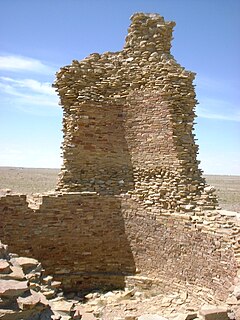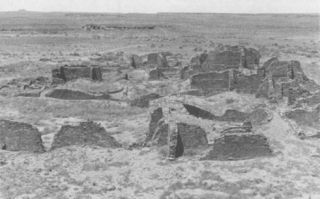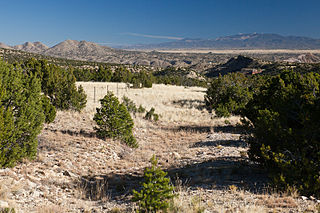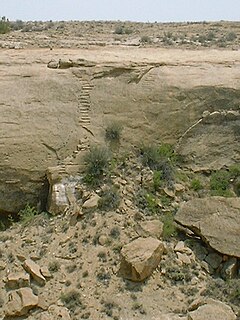Related Research Articles

Chetro Ketl is an Ancestral Puebloan great house and archeological site located in Chaco Culture National Historical Park, New Mexico, United States. Construction on Chetro Ketl began c. 990 and was largely complete by 1075, with significant remodeling occurring in the early and mid-1110s. Following the onset of a severe drought, most Chacoans emigrated from the canyon by 1140; by 1250 Chetro Ketl's last inhabitants had vacated the structure.

Pueblo del Arroyo is an Ancestral Puebloan great house and archaeological site located in Chaco Culture National Historical Park, in New Mexico, United States.

Kin Ya'a is a Chacoan great house and the center of a significant Ancestral Puebloan outlier community. It is located near Crownpoint, New Mexico on the Dutton Plateau, 25 miles (40 km) south of Chaco Canyon.
Escavada Wash is a tributary of the Chaco Wash, in Chaco Canyon, New Mexico, United States. It flows south and west from its origin near Lybrook and meets the Chaco Wash at the west end of the canyon. Several small Ancestral Puebloan archeological sites border the wash, which is located north of the Chacoan great house Pueblo Alto.
Francisco Hosta was the civil governor of Jemez Pueblo in 1849. He acted as a guide for several archeological expeditions to the Ancestral Puebloan ruins in Chaco Canyon, including the Simpson group in 1849, one led by Dr. Oscar Lowe in 1874, and in 1877 he guided photographer William Henry Jackson, who named Hosta Butte in his honor. He might have also guided José Antonio Vizcarra during his 1823 campaign against the Navajo people, during which Vizcarra re-discovered Chaco Canyon.
Atlatl Cave is an important archaeological site that contains organic evidence of occupation by Archaic North Americans c. 900 BCE. It is located at the west end of Chaco Canyon, New Mexico at an elevation of 1910 meters. During the 1970s, archaeologists discovered corn, beans, squash, a yucca fiber sandal, a variety of different kinds of miniature beads made from juniper, basketry, juniperus monoserma and juniperus scopulorum twigs, pseudotsugamenziesii wood fragments, and fabric made from rabbit fur in the cave. The breaths of the Archaic-age maize pollen grains are significantly larger than Puebloan and present maize pollen. They also found part of an atlatl, or spear-thrower, from which the site got its name. Atlatl Cave is important because unlike most Archaic sites in the canyon, the shelter protected the organic materials inside, which allowed for accurate radiocarbon dating.
Leyit Kin is an Ancestral Puebloan small house archeological site located 1 mile (1.6 km) southeast of Pueblo Bonito near the south end of Chaco Canyon in New Mexico, United States. Leyit Kin contains three kivas and twenty-seven rooms. It was occupied during three distinct periods ending in the late 12th century. The site was partially excavated in 1934 and 1936, but backfilling has made the structures nearly indistinguishable from the surrounding landscape.

Bis sa'ani is an Ancestral Puebloan great house and small house community and archeological site. Located in Chaco Canyon, New Mexico, United States, it contains thirty-five rooms and lies near the south of Escavada Wash 8 miles (13 km) from Pueblo Bonito. While outside the canyon, it is not considered an outlier, but included within the core group of ruins. There are several small house sites in the area, but no great kiva. Bis sa'ani was occupied during the early 11th century.

Kin Bineola is an Ancestral Puebloan great house and archeological site located 12 miles (19 km) from Pueblo Bonito in Chaco Culture National Historical Park, New Mexico, United States. Construction on the core of the building, which is E-shaped, began in the early 10th century; it was significantly remodeled and enlarged during the 12th century. At its peak Kin Bineola contained nearly 200 rooms and 10 kivas, with an associated great kiva nearby. Irrigation canals have been uncovered at the site, which lies north of Kin Bineola Wash, where several small house sites have been found.
Bluff Great House is an Ancestral Puebloan great house and archeological site located in southeastern Utah, United States. The site lies near the north bank of the San Juan River, approximately 130 miles (210 km) northwest of Chaco Culture National Historical Park. It contained between fifty and sixty rooms, with four kivas and a great kiva nearby. Two ancient road segments were found in the area, and several berms were leveled to create a terrace, which is rare in Chacoan sites. The great house was partially excavated from 1996 to 2004, and archeologists believe the site was constructed, in at least two stages, between 1075 and 1150 CE by Chacoans who interacted with the Puebloan residents of both Mesa Verde and Kayenta, Arizona. Bluff Great House was abandoned c. 1250.

The Cerrillos Turquoise Mines are Ancestral Puebloan turquoise mines located in the Cerrillos Hills, 20 miles (32 km) southwest of Santa Fe, New Mexico. Archeologists believe that most of the turquoise found at Chaco Canyon was mined in the Cerrillos Hills. Many modern Pueblo people claim to have ancient rights to these mines. In 1977, neutron activation analysis linked an artifact from Chetro Ketl to the Cerrillos mines.
The Chaco Meridian is a north-south axis on which lie the Ancestral Puebloan sites, Aztec Ruins and Chaco Canyon, as well as Paquime at Casas Grandes in northern Mexico. Archeologist Stephen H. Lekson developed the theorizes that the location of these sites approximately on the same line of longitude (107°57'25") was intentional, and represents a ceremonial and political connection between the sites and is due to migration of the rulers of the Ancestral Puebloan moving their capital city.
The Chacra Face Road is one of eight Ancestral Puebloan roads that enters Chaco Canyon, New Mexico. It enters the canyon through a break in the Chacra Mesa called the Fajada Gap, and ends at the great house Una Vida. It probably connected Una Vida to an eastern Puebloan community, Guadalupe Outlier.
Dune Dam is a long sand dune that lies at the western end of Chaco Canyon, New Mexico, near the confluence of the Chaco and Escavada Washs. The dune was created by winds that brought sand up the Chaco River. When the dune was large enough, it dammed the Chaco Wash and created a small and shallow lake near the Ancestral Puebloan great house, Penasco Blanco. Archeological evidence suggests that the dune was breached around 900 CE. Chacoans filled the breach with masonry sometime in the early 11th century, and built an accompanying reservoir lined with stones that was visible until 1920. The dam stopped Chaco Wash from further deepening, which helped raise the water table in the canyon, aiding Chacoan farming. The absence of a lacustrine plain behind the dam led geologist Stephen A. Hall to question this interpretation.
East Community is an Ancestral Puebloan great house community and archeological site located 12 miles (19 km) east of Pueblo Bonito, at the eastern end of Chaco Culture National Historical Park, New Mexico. Archeological evidence uncovered during the 1980s suggests the site was occupied by both Chacoans and Mesa Verdeans. Eighty-two structures have been identified in the area, including a great house that contains twenty-five rooms and several small house sites. At least one kiva has been uncovered there, but no great kivas. A partial road segment is visible there, but archeologists are unsure if it connects with a longer segment thought to originate near Pueblo Pintado. The great house at East Community was constructed in the 10th century, with significant additions completed during the 11th century. The associated small house sites were occupied by Chacoans from 875 to 1300, and thirty-nine of them by Mesa Verdeans, from 1175 to 1300. Archeologist Thomas Windes believes the site was linked to Chaco Canyon through a system of signaling stations atop the area's mesas.

Halfway House Outlier is a small, twelve-room, one-story Ancestral Puebloan great house and archeological site located in New Mexico, United States. It lies halfway between Chaco Canyon and Salmon Ruins, on the Great North Road. Halfway House appears to have been built in relation to the road, and was probably an orientation point used during the road's construction.

The Great North Road is an Ancestral Puebloan road that stretches from Pueblo Alto, in Chaco Canyon, New Mexico, to Kutz Canyon in the northern portion of the San Juan Basin. It is thought to follow Kutz Canyon to the San Juan River and Salmon Ruins. Several archeological sites along the road are thought to have been ancient way stations, including Halfway House Outlier, Pierre's Outlier, and Twin Angels Outlier. The Great North Road is one of the best studied Chacoan roads, and includes four parallel roads along some segments, as well as low masonry features thought to be curbs. Herraduras are often found along segments of the road system.
Hosta Butte is an ancestral site southwest of Chaco Culture National Historical Park, New Mexico. Along with Gobernador Knob and Huérfano Mountain, it forms part of the Dinétah, considered to be the birthplace of early Navajo culture. The mountain, with an elevation of 8,622 feet (2,628 m), is in close proximity to Crownpoint, New Mexico. Due to its prominence in the cosmography of Native tribes in the area, the mountain contains a number of small shrines. In 1877, photographer William Henry Jackson named the butte in honor of Francisco Hosta, who guided him to the Ancestral Puebloan ruins in Chaco Canyon.

The Jackson Staircase is a pair of Ancestral Puebloan steps cut into the cliff of Chaco Canyon, New Mexico. Located north of Chetro Ketl and east of Pueblo Alto, the stairs gave Chacoans access to the Great North Road. The feature is named after William Henry Jackson, who discovered the stairs in 1877.
Mexican Springs Road is an Ancestral Puebloan road that parallels Coyote Canyon Road. It runs from South Gap in Chaco Canyon to the southwestern portion of the San Juan Basin. It has only been identified through aerial photography, and no physical trace of it is visible from the ground. The lack of pueblos along its path has led some to question its designation as a Chacoan road.
References
- ↑ Snow, Dean R. (2015-09-04). Archaeology of Native North America. Routledge. ISBN 978-1-317-35006-4.
- ↑ Frazier, Kendrick (1999). People of Chaco: A Canyon and Its Culture. W.W. Norton. ISBN 978-0-393-31825-8.
- ↑ Vivian & Hilpert 2012, pp. 109–10.